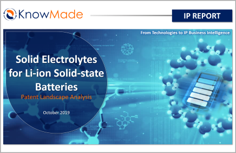
Solid electrolyte material is the key ingredient in solid-state batteries. This patent analysis will empower your understanding of the main R&D trends and competitors’ technological strategies found in the solid electrolyte materials jungle.
Publication October 2019
| Download Flyer | Download Sample |
Report’s Key Features

- PDF with > 250 slides
- Excel file > 5,800 patents
- IP trends, including time-evolution of published patents, legal status, countries of patent filings, etc.
- Ranking of main patent assignees
- Patent categorization by type of electrolyte (polymer, inorganic, inorganic/polymer) and inorganic electrolyte materials (sulfide glass ceramics, Thio-LISICON, argyrodite, oxide glass ceramics, NASICON, perovskite, garnet, anti-perovskite, hydride)
- For each technical segment: IP dynamics, ranking of main patent assignees, newcomers, key IP players (leadership, blocking potential, portfolio strength), key patents, and recent development trends
- For each key IP player (100+ companies): Time-evolution of patenting activity, legal status of patents and countries of patent filings, patent segmentation by electrolyte material, IP strengths and weaknesses by electrolyte material
- Excel database containing all patents analyzed in this report, including technology and material segmentations
More battery patent landscapes. Explore the patent landscape and gain unique insights through our custom studies.
Car and battery manufacturers also have a notable IP position in solid electrolyte materials
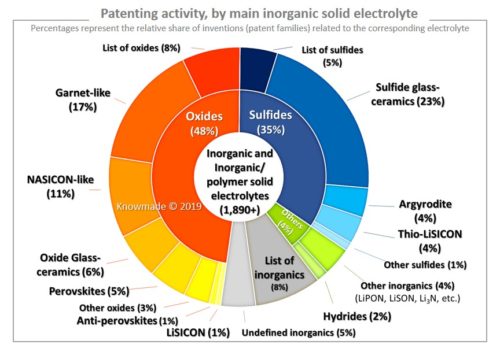 Everyone still recalls the drama surrounding the Samsung Galaxy Note 7 smartphone, which revealed a major drawback for today’s Li-ion batteries: the safety risk induced by the use of liquid-flammable electrolytes. One technical solution envisioned for improved safety is to replace the liquid electrolyte with a solid electrolyte. Solid-state batteries can be categorized in two categories: thin-film solid batteries and bulk solid batteries. The thin-film technology approach, proven for thin-film batteries, is not directly applicable for bulk solid-state batteries. Thus, new processes and materials must arise to ensure “bulk” solid batteries meet market requirements (performance, stability, cost). Three main development axes are envisioned for enhancing “bulk” solid-state battery performance: improve solid electrolyte performances and electrode/electrolyte interface, and develop materials/cell assembly manufacturing processes compatible with industrial production. Many companies have recently announced the commercialisation and integration of batteries with solid electrolytes (solid-state batteries) by 2020 – 2025. However, many questions remain: which solid electrolyte exhibits the most promising performance? What are the most recent technology developments for solid electrolyte materials? Who has the best IP position in solid electrolyte materials? In this context, a patent analysis is a complementary approach to market research in order to fully comprehend the competitive landscape and technology roadmap; stay abreast of cutting-edge technology developments; anticipate future technological consolidation; and understand competitors’ strategies. This patent analysis also reveals the companies, technical solutions, and strategies not identified by a market analysis.
Everyone still recalls the drama surrounding the Samsung Galaxy Note 7 smartphone, which revealed a major drawback for today’s Li-ion batteries: the safety risk induced by the use of liquid-flammable electrolytes. One technical solution envisioned for improved safety is to replace the liquid electrolyte with a solid electrolyte. Solid-state batteries can be categorized in two categories: thin-film solid batteries and bulk solid batteries. The thin-film technology approach, proven for thin-film batteries, is not directly applicable for bulk solid-state batteries. Thus, new processes and materials must arise to ensure “bulk” solid batteries meet market requirements (performance, stability, cost). Three main development axes are envisioned for enhancing “bulk” solid-state battery performance: improve solid electrolyte performances and electrode/electrolyte interface, and develop materials/cell assembly manufacturing processes compatible with industrial production. Many companies have recently announced the commercialisation and integration of batteries with solid electrolytes (solid-state batteries) by 2020 – 2025. However, many questions remain: which solid electrolyte exhibits the most promising performance? What are the most recent technology developments for solid electrolyte materials? Who has the best IP position in solid electrolyte materials? In this context, a patent analysis is a complementary approach to market research in order to fully comprehend the competitive landscape and technology roadmap; stay abreast of cutting-edge technology developments; anticipate future technological consolidation; and understand competitors’ strategies. This patent analysis also reveals the companies, technical solutions, and strategies not identified by a market analysis.
This report focuses on solid electrolyte materials. More than 5,800 patents grouped in 2,760 patent families are related to solid electrolytes for solid Li-ion batteries. In this report, we reveal the main IP trends, key patented technologies, recent development trends, key IP players and newcomers and their IP strategies/strengths by solid electrolyte material (polymer, polymer/inorganic, inorganic, argyrodite, Thio-LISICON, sulfide glass ceramic, oxide glass ceramic, perovskite, anti-perovskite, LiSICON, garnet, NASICON, hydrides, etc.).
Get an overview of solid electrolyte material properties
This report provides an overview of the electrochemical and chemicophysical properties, as well as the advantages and drawbacks of the main solid electrolyte materials developed for solidstate Li-ion batteries – with a special focus on their ionic conductivities.
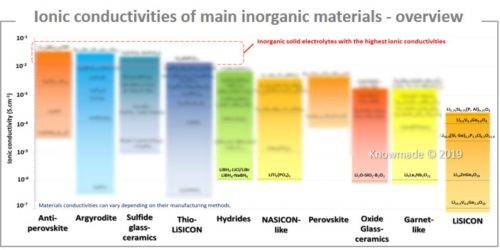
Understand patented technology and the competitive landscape
The 2,760+ patented inventions selected for this study are categorized by type of electrolyte (polymers, inorganic/polymer, inorganic) and inorganic electrolyte materials (argyrodite, ThioLISICON, sulfide glass ceramic, oxide glass ceramic, perovskite, anti-perovskite, LiSICON, garnet, NASICON, hydride). For each electrolyte material, this report includes a timeevolution of patent applications, main and key patent assignees, newcomers, and a description of key and recently patented technologies. An understanding of the current technical challenges addressed in the patents is also presented. Key IP players in solid electrolyte materials are not only material manufacturers and R&D labs, but also electronic component manufacturers, battery manufacturers, and end-users.
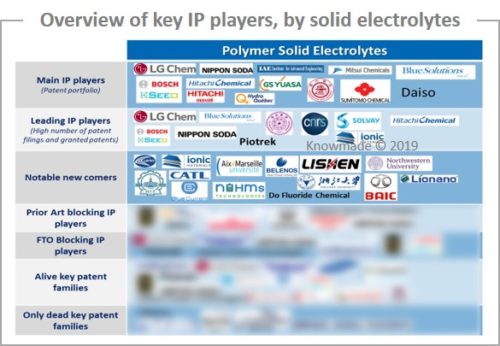
Know key players’ ip positions and IP strategies
More than 1,140 patent applicants are involved in the solid electrolyte for Li-ion solid-state battery patent landscape. This report reveals the IP position of key players, by solid electrolyte materials (polymers, argyrodite, Thio-LISICON, sulfide glass ceramic, oxide glass ceramic, perovskite, anti-perovskite, LiSICON, garnet, NASICON, hydride) through a detailed analysis of their patent portfolios. We also provide insights regarding these players’ patented technologies, their IP strategy, and their ability to limit other firms’ patenting activity and/or freedom-to-operate. The benchmarking of patent assignees is evaluated by solid electrolyte materials, on the basis of their IP portfolio size, prior-art contribution, geographical coverage, and enforceability of patents. A special focus is placed on the main IP collaborations (co-assignement, licensing, IP transfer) related to solid electrolytes for Li-ion solid-state battery.
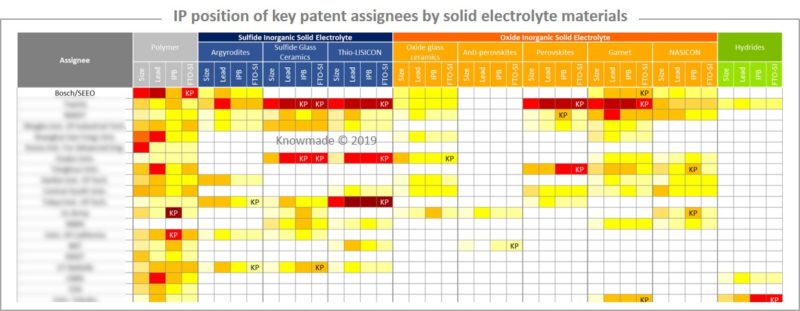
Useful excel patent database
This report also includes an Excel database with the >5,800 patents and patent applications analyzed in this study. This useful patent database allows for multi-criteria searches and includes patent publication numbers, hyperlinks to the original documents, priority date, title, abstract, patent assignees, patent’s current legal status, and technological and application segments.
